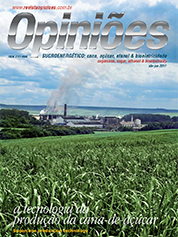Alberto Menoni
Director of Auteq Telemática
Op-AA-28
Automation in agriculture results in savings
It has been a while since automation was introduced in the field. Although automation in agriculture is no novelty, several elements have contributed to its recent development, such as the connection to the CAN machine and vehicle network, increased processing capacity of onboard equipment, geo-referencing of exploited areas, better GPRS coverage in the field, and the adoption of “Web” technologies when interfacing with users.
Automation in agriculture entails several benefits for the sugarcane production process, such as, for example, the reduction of fuel consumption and of maintenance expenses of machines and vehicles, the productivity increase of machines, vehicles and their operators, better quality of machine and operator reports and of the sugarcane certificate, of telemetry, tracking and better control of services rendered, along with better allocation of sugarcane trucks to the cutting work fronts.
All these benefits ultimately result in the cost reduction of agricultural operations. However, given that it is essentially a biological process, agriculture is complex, making it difficult to identify the impact of changes resulting from automation in agriculture with respect to any variable considered individually. The dimension of the impact also depends on the situation prior to the implementation of automation in agriculture in the mill.
We dispose of reports of clients informing of reductions between 5% and 19% in fuel consumption and 15% to 35% in fleet maintenance costs of machines and heavy equipment. Cost Reductions: It does not suffice to invest in large machines to increase productivity in the field.
Automation in agriculture makes it possible to better understand the entire process of motor mechanization, helping companies reduce costs. With it, it is possible to answer questions such as: How productive is each machine and each operator? Where is harvester Z at this moment and what is it doing? For how long? Why did tractor X stop? In what direction should I send this empty trailer truck? Is the contracted third party rendering the service? In the right place? With the right quality? Etc.
Typically, a good automation solution in agriculture comprises onboard computers, handheld computers, radio communication stations (Bluetooth and W-LAN), electronic panels, communication software, analysis software, telemetry and tracking software, interfaces with different corporate systems (PIMS, GAtec, SAP, etc.) and implementation services, technical support and consulting services, encompassing several functions: registration of sensor information; registration of administrative information in the field; telemetry and tracking and logistics support.
Registration of sensor information: Automation in agriculture allows registering, minute by minute, all variables on machines or vehicles and the instant relaying of deviations with respect to operation parameters pre-established by the mill. It is thus possible to immediately reduce fuel and maintenance costs, along with the reduction of accident risk.
The return on investment always occurs in less than six months. Experience also shows that the benefits of the system are multiplied with the implementation of incentive and/or variable compensation programs tied to grades drivers and operators obtain, based on information collected by onboard computers.
Registration of information in the field: Through the registration of information in the field, it is possible to obtain validated data on the electronic cargo certificate, reports on operator/driver shifts, and daily reports on machines and vehicles. Thus, one need not depend on any incorrect annotation or the loss of a paper or label.
It also allows assigning the weighing machine operator to other activities, expediting a process in which each second counts, given that the weighing machine is a bottleneck for the entry of sugarcane into the mill. Furthermore, it also allows the control of the sugarcane’s origin (for the sake of paying sugarcane suppliers, for example), and tracking cargo classified by production on individual lots, thereby obtaining an approximate productivity map.
Telemetry and tracking: Telemetry functions allow for instant long distance communication on deviations relative to operation parameters pre-established by the mill and on all changes in operation. The tracking package usually includes code, brand and model of vehicles/machines, the code of operators/drivers, the activity or reason for a stop, the time required for such activity and the machine/vehicle location.
Logistics support: Automation in agriculture also allows providing current information for the truck allocation system in a dynamic manner (real time), based on actual information rather than theoretical travel times. This allows increasing fleet productivity and possibly re-dimensioning investment in sugarcane trucks. Management must measure in order to manage, and in light of the challenge faced by the motor mechanization manager in a mill, who handles perhaps 800 machines and vehicles, the implementation of a solution for automation in agriculture becomes a matter requiring special attention.




